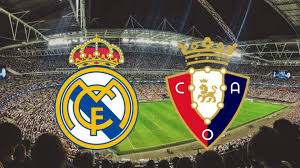
Introduction to the Rivalry
When you think of Spanish football, the first names that come to mind are usually Real Madrid, Barcelona, and Atlético Madrid. Yet, within La Liga’s competitive fabric lies another fascinating fixture: Real Madrid vs Osasuna. It might not carry the same global spotlight as El Clásico, but make no mistake—this matchup is a fierce battle of prestige, passion, and footballing grit.
Real Madrid, the crown jewel of Spanish and European football, enters every match with the weight of history and expectation. Their style has always been about flair, dominance, and the pursuit of silverware. On the other hand, Osasuna, hailing from Pamplona, represent resilience, discipline, and the underdog spirit. What makes this clash exciting is not just the difference in resources or fame but the unpredictable nature of their games.
For Real Madrid, Osasuna often poses an inconvenient hurdle in the race for La Liga. Matches at El Sadar Stadium, in particular, are notorious for being tricky. The atmosphere is electric, the fans are unforgiving, and the team channels their passion into an intense, physical style of football. Even the biggest stars of Real Madrid have found themselves frustrated in Pamplona.
Why does this matchup attract so much attention? Because it represents more than just points—it’s a clash of footballing identities. Real Madrid, with their galaxy of stars, often face a team that thrives on unity and collective strength. This David vs Goliath narrative is what makes every Real Madrid vs Osasuna game unpredictable and captivating.

Historical Background
The rivalry between Real Madrid and Osasuna is not born out of geographical proximity or political differences but out of competitive spirit. The first official meeting dates back to the early decades of La Liga, when Osasuna, a smaller club compared to Madrid’s grandeur, started making a name for themselves by putting up gritty performances.
Early Encounters Between the Two Clubs
During the initial years, Real Madrid unsurprisingly dominated most meetings, boasting superior talent and tactics. However, Osasuna quickly gained a reputation for being a tough opponent, especially at home. Even in the 1960s and 70s, Madrid struggled on trips to Pamplona, where narrow pitches and fiery crowds created a hostile environment.
Memorable Clashes in La Liga
Over time, matches between these two teams produced unforgettable moments. Whether it was Real Madrid needing a win to chase the title or Osasuna fighting to avoid relegation, the stakes were always high. In several seasons, Madrid dropped crucial points against Osasuna, which influenced the title race dramatically.
Copa del Rey Battles
Aside from La Liga, the Copa del Rey has also witnessed their fiery encounters. Cup games often bring out the best in underdogs, and Osasuna has taken full advantage of the do-or-die nature of knockout football. In some instances, they managed to knock Madrid out or at least stretch them to the limit, earning respect across Spain.
The historical backdrop of this rivalry tells us one thing—while Real Madrid may hold the lion’s share of victories, Osasuna has never been an easy opponent. Every meeting carries a sense of unpredictability that keeps fans glued to their seats.
Head-to-Head Record
When looking at numbers, Real Madrid undeniably enjoys the upper hand. With decades of dominance in La Liga, Los Blancos have racked up far more wins against Osasuna than losses. However, statistics alone don’t tell the whole story.
Overall Win-Loss Statistics
Real Madrid’s winning percentage in this fixture is high, with many commanding victories at the Santiago Bernabéu. Yet, Osasuna has managed to snatch surprising draws and wins, especially when Madrid’s focus was divided between domestic and European competitions.
Biggest Wins and Upsets
Some of Madrid’s most dominant displays include 7-1 and 6-0 thrashings, showcasing their attacking prowess. But on the flip side, Osasuna has produced some famous upsets, such as victories in Pamplona that sent shockwaves through La Liga. These moments are cherished in Osasuna’s history as symbols of their fighting spirit.
Performance at Santiago Bernabéu vs El Sadar
At the Bernabéu, Real Madrid usually enjoys smooth sailing, thanks to their overwhelming support and larger pitch that suits their attacking football. But at El Sadar, it’s a different story. The compact, hostile atmosphere often tilts the game in Osasuna’s favor. Many Madrid stars—past and present—have admitted that El Sadar is one of the toughest away grounds in Spain.
This head-to-head dynamic adds spice to every upcoming encounter, making fans wonder—will it be another Real Madrid show, or will Osasuna spring a surprise?

Playing Styles of Both Teams
When analyzing this rivalry, one must understand the contrasting philosophies that define both teams.
Real Madrid’s Tactical Approach
Real Madrid thrives on possession, creativity, and clinical finishing. Over the decades, their system has evolved—from the Galácticos era of attacking fireworks to the tactical balance under managers like Zidane and Ancelotti. Madrid loves to stretch the pitch, dominate midfield battles, and rely on individual brilliance from stars like Vinícius Jr., Benzema (earlier), or Jude Bellingham today.
Osasuna’s Defensive Discipline and Counter-Attacks
Osasuna, in contrast, adopts a pragmatic approach. Their football revolves around compact defending, aggressive pressing, and quick counter-attacks. They rarely try to outplay Madrid in open football; instead, they frustrate them with resilience and capitalize on mistakes. Their aerial threat and set-piece strength also make them dangerous.
Key Tactical Battles on the Pitch
The outcome of Real Madrid vs Osasuna often hinges on key battles:
- Madrid’s creative midfield vs Osasuna’s disciplined defensive block.
- Speed of Madrid’s wingers vs physicality of Osasuna’s full-backs.
- Transition play, where Osasuna tries to exploit spaces left behind by Madrid’s attacking push.
This contrast of styles makes their matches chess-like, where patience, precision, and mentality decide the winner.
Key Players Over the Years
Every rivalry has its heroes, and Real Madrid vs Osasuna is no different.
Real Madrid Legends Who Shaped the Rivalry
Icons like Raúl, Ronaldo Nazário, Cristiano Ronaldo, and Sergio Ramos have all left their mark against Osasuna. Cristiano, in particular, enjoyed a prolific scoring record, often deciding games with his ruthless finishing. Goalkeepers like Iker Casillas also played vital roles in frustrating Osasuna’s attacking efforts.
Osasuna Heroes Who Stood Tall Against Giants
On the other side, Osasuna has produced warriors who stood tall against Madrid’s might. Players like Patxi Puñal, Enrique Martín, and more recently Chimy Ávila, have become cult heroes for their fearless performances. These players represent Osasuna’s spirit—always ready to challenge the giants of Spanish football.
Current Stars to Watch Out For
In today’s context, Vinícius Jr., Jude Bellingham, and Rodrygo are the big names driving Madrid forward. For Osasuna, players like David García (captain and defensive rock) and Ávila provide strength and determination. These stars embody the essence of the modern rivalry.

Real Madrid’s Dominance in La Liga
When discussing La Liga dominance, it’s impossible not to place Real Madrid at the center of the conversation. With more league titles than any other Spanish club, their supremacy is a defining feature of the competition. But interestingly, clashes against Osasuna often highlight how difficult it is to maintain such dominance over time.
Consistency in Domestic Competitions
Real Madrid’s success is built on consistency—winning not just the big games against Barcelona or Atlético, but also grinding out results against mid-table and relegation-threatened sides. That’s where Osasuna comes in. On paper, Madrid is the clear favorite every season, but matches against Osasuna sometimes remind fans that consistency is earned, not given. Dropped points against Pamplona’s warriors have cost Madrid in title races, proving that even the most powerful clubs cannot afford complacency.
How They Approach Games Against Mid-Table Teams
Madrid usually rotates their squad when facing mid-table clubs like Osasuna, especially if they are juggling Champions League fixtures. This strategy has backfired on occasions, with Osasuna exploiting those opportunities. For Madrid, these fixtures demand focus—because every point counts in La Liga, and history shows that small slip-ups can determine the title’s destination.
Why Osasuna Presents a Unique Challenge
Unlike some mid-table teams that crumble under Madrid’s pressure, Osasuna brings grit and tactical discipline. Their physical play, relentless pressing, and ability to disrupt Madrid’s rhythm make them stand out as a unique challenge. Many Madrid managers have admitted that winning at El Sadar requires not just skill but also character and patience.
Osasuna’s Fighting Spirit
What makes Osasuna so admired across Spain is not a trophy cabinet filled with silverware but their unyielding fighting spirit. They embody the essence of a club that thrives on identity, fan passion, and relentless determination.
The Club’s Identity and Fan Culture
Founded in 1920, Osasuna is more than just a football club—it’s a symbol of pride for Pamplona and the Navarre region. The fans, known for their loyalty and intensity, transform El Sadar into one of the most intimidating grounds in Spain. Unlike glamorous clubs with international fanbases, Osasuna thrives on local passion. When Real Madrid arrives, the atmosphere is electric, with fans creating a hostile cauldron that pushes their players beyond their limits.
Their Strategy Against Big Clubs
Osasuna’s approach against big clubs like Real Madrid is simple yet effective—stay compact, frustrate them, and hit on the counter. They don’t aim to outplay Madrid in possession but rather test their patience. By closing down spaces, disrupting passing lanes, and making every duel physical, they force Madrid to earn every inch on the pitch.
Famous Victories Against Real Madrid
Over the years, Osasuna has celebrated several famous wins against Madrid. One of the most memorable came in 2004 when they stunned Los Blancos with a 3-0 win at El Sadar. These victories live long in the memories of fans, proving that in football, heart can sometimes overcome resources. Every such result adds another chapter to the narrative of their rivalry.

Memorable Matches Between Real Madrid and Osasuna
Football rivalries are defined by unforgettable moments, and Real Madrid vs Osasuna has provided plenty. Some matches have been thrilling goal-fests, while others were tense battles of nerves.
Classic Encounters at Bernabéu
At the Santiago Bernabéu, Madrid has delivered several spectacular performances. Fans still recall the 2008 clash when Real Madrid thrashed Osasuna 7-1, with relentless attacking play. Matches like these showcase Madrid’s dominance but also highlight Osasuna’s courage—they never stop fighting, even when the odds are stacked against them.
Thrillers at El Sadar
El Sadar has hosted some of the most dramatic clashes. One such encounter came in 2011 when Osasuna beat Madrid 1-0, dealing a blow to their title hopes. These kinds of results show why Pamplona is considered one of the toughest away trips in Spain. The narrow pitch, close stands, and passionate fans create an atmosphere where even the mightiest stumble.
Matches That Decided La Liga Titles
There have been instances where Osasuna’s results against Madrid influenced the title race directly. In seasons where Barcelona and Madrid were neck and neck, dropped points in Pamplona shifted momentum in favor of one or the other. In that sense, Osasuna has played a crucial, though indirect, role in shaping La Liga history.
Managerial Influence on the Rivalry
Managers play a massive role in how teams approach rivalries, and this fixture has seen its fair share of tactical battles.
Managers Who Defined Real Madrid’s Strategy
Legends like Vicente del Bosque, José Mourinho, Zinedine Zidane, and Carlo Ancelotti all approached Osasuna differently. Mourinho, for instance, often struggled at El Sadar, where his attacking systems were tested by Osasuna’s resilience. Zidane, on the other hand, preferred patience and individual brilliance to unlock Osasuna’s defense.
Osasuna Coaches and Their Tactical Masterclasses
On Osasuna’s side, coaches like Jagoba Arrasate have been instrumental in extracting maximum potential from limited squads. Their tactical discipline, defensive organization, and motivational strength often make them capable of frustrating Madrid’s stars. Arrasate’s ability to adapt to opponents while keeping Osasuna’s identity intact is a testament to his managerial intelligence.
Current Managerial Approaches
Today, under Ancelotti and Arrasate, the clash continues to be a fascinating duel of ideas. While Ancelotti focuses on balance and star power, Arrasate emphasizes unity and collective strength. Every encounter becomes a battle not just of players but of philosophies.

Fanbase and Atmosphere
No rivalry feels complete without the roar of fans, and in this case, both clubs bring unique atmospheres that define the fixture.
Santiago Bernabéu’s Intimidating Aura
The Bernabéu is iconic—a stadium where history breathes in every corner. When Osasuna visits, they face not only Madrid’s players but also nearly 80,000 fans demanding victory. The intimidating aura often rattles smaller teams, though Osasuna’s fearless mentality sometimes allows them to rise to the occasion.
El Sadar’s Fortress Mentality
El Sadar, though smaller, is a fortress in its own right. With a capacity of around 23,000, the stadium feels like a pressure cooker. The fans are right on top of the players, making every whistle, cheer, and chant echo with intensity. For Real Madrid, it’s one of the toughest grounds to conquer, and many title races have seen them stumble here.
Traveling Fans and Their Passion
Madrid’s traveling fans also add to the rivalry’s flavor. Even in Pamplona, you’ll spot sections of white jerseys and hear chants for Los Blancos. The clash of fan cultures—Madrid’s global identity vs Osasuna’s regional pride—creates a fascinating backdrop for this fixture.


